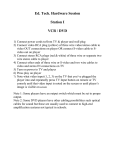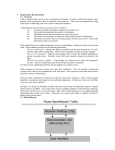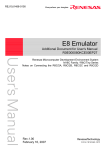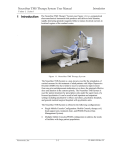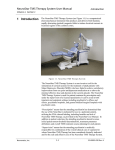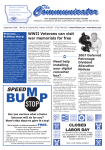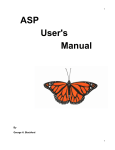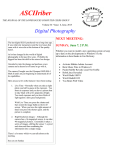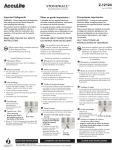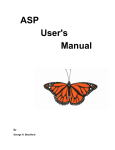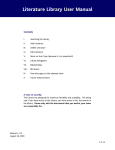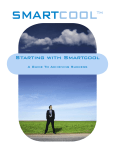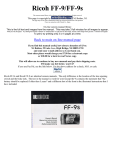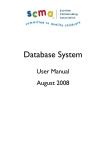Download Read More - Applied Marketing Science, Inc.
Transcript
VISIONS i s s ue 3, 2 012 • V OL ume 3 6 • NO. 3 Insights into In novation™ S N O S S E L O R M F D E N R A G N I D E N A L TST U E T A R O O P R CO VATORS O N IN 10 + 16 Want to Jump-Start Your Product Development? 20 The Back End of Innovation 30 Highlights of PIM 2012 Conference The Back End of Innovation By Gerry Katz, NPDP I n my July 2011 Visions article, “Re-thinking the Product Development Funnel,” I proposed a new and somewhat different version of the classic visual depiction of the new product development process. But at the end of the article, I made the observation that almost all of our attention and academic research over the past 20 years has been focused on the earlier parts of the process, the part that is often referred to as the “fuzzy front end” of new product development (NPD). I expressed a wish that perhaps it was time to focus more of our attention on the later stages. A few months later, in conversations with several people who were putting together a conference focusing on the “back end of innovation,” it became clear to me that there was little agreement as to just what that term meant. So, while I would stop short of claiming that my definition is the only correct 20 issue 3, 2012 • VISIONS one, this article is an attempt to at least start that conversation. Just to recall, the funnel that I proposed (see Figure 1) gave greater definition to the earlier stages than any of the previous funnels that had been proposed by Urban and Hauser, Cooper, Wheelwright and Clark, and McGrath. It also placed ideation after many of these early activities that are commonly associated with the “fuzzy front end,” whereas most of the funnels that had been proposed earlier placed ideation as the very first activity and often before even entering the funnel. One definition of the “back end Figure 1: A New, New Product Development Funnel Figure 2: Phases of Innovation Process of innovation” defined it as everything that occurs after ideation. But if that were the case, it is difficult to see how this differs from the front end. What we need is a clearer demarcation line that separates all of these activities more succinctly. A Definition To me, the back end of innovation begins at the point where the product or service has been defined, designed and developed. In terms of the PDMA’s Body of Knowledge, it can be thought of as those parts of the process that occur after discovery and development and at the point where we are about to enter the stage of commercialization (see Figure 2). While it might seem that all of the hard decisions have now been made, as you will see, there is much yet to do! These activities can be classified into six major categories: 1.Product 4. Logistics 2. Marketing 5. Field Support 3. Manufacturing 6. Customer Service Product First, no matter how well we’ve thought through the design of our product or service, there are always some surprises that occur when we get to market. Many of these can be corrected without too much difficulty, if caught early enough in the launch phase. A recent speaker from 3M told such a story regarding its new medication patch product. In doing customer research, 3M learned that many patients found these patches to be quite unsightly, and so it made its new product transparent and therefore nearly invisible. However, a few months into the launch, 3M received reports from physicians and caregivers of elderly patients with as many as eight patches still in place. Apparently, because the patches were so hard to see, some patients were either forgetting or failing to remove the old ones before applying the new ones. Similarly, 3M developed a pricing strategy of providing twice the product for the same price (i.e., 60 patches in a box for about the same price that they and others had previously charged for 30). However, 3M had not anticipated the impact of this decision on the insurance system. Most payers will only provide a 30-day supply of medicationrelated products, making it complicated or impossible to participate in this critical part of the market. This type of information usually only emerges from market research conducted during the launch or from careful monitoring of customer complaints. Fortunately, many of these issues can be corrected in time, but they must be recognized in order to be dealt with. Marketing Although we now have a pretty firm idea of what our product or service will be, there are still a number of important marketing decisions that need to be managed. For instance: • Product name. First, we must give our new product or service a name. In the world of Consumer Packaged Goods, this VISIONS • issue 3, 2012 21 ❯ activity is usually the subject of a great deal of time, research and resources. Creativity consultants are hired, and alternative names are often tested with consumers using formal quantitative market research. However, in the B2B world, many companies give little thought to this activity beyond trademarking. They simply use an existing name with a new number, e.g., the AccuLite 400 as the next generation version of the AccuLite 300. (In fact, some have questioned what Boeing will do in a few years time. They started with the Boeing 707 and have just introduced the 787. I’ve been told that there is a 797 on the drawing boards, but what then?) Product naming might represent a lost opportunity, because we all know that a name can be an important element of a product’s image and customer response to it. Whether we evaluate alternative names using qualitative or quantitative research, this seems to be an important activity that would not be overly expensive to pursue. • Positioning. While many companies place considerable emphasis on the messaging they intend to use to describe their products, these activities are usually only thought of as “talking points” for the sales force. The concept of positioning, however, is more complex. It deals with the image of the product relative to competition and its key points of differentiation. Traditional research in this area concludes that a product’s positioning not be overly complicated. We need to convey how we are different in no more than two or three points of comparison that can be expressed in a matter of seconds. Indeed, this is the world of “tastes great, less filling,” the four-word positioning used in the launch of Miller Lite more than 30 years ago! This is also an area where market research has much to contribute. Alternative positionings can be tested using traditional focus groups, online discussion boards and/or quantitatively using perceptual mapping (See Figure 3, courtesy of Professor Abbie Griffin, University of Utah). • Price. This is an area which, fortunately, does get considerable attention in most companies. There are a myriad of issues to consider, such as price relative to the competition, relative to other items in your product line and desired margin. However, many of the necessary decisions are far more complicated. We need to decide what parts of our product or service will be included in the base price and what things to think of as additional options. 22 issue 3, 2012 • VISIONS Figure 3: Perceptual Map of the Beer Market And then, we need to figure out how much to charge for the base product and how much for each of the options. This raises the thorny issue of bundling. Take, for example, how cable or satellite TV services deal with this problem. Which channels are included in the basic service and which do they charge extra for? And when they do charge extra, should it be à la carte or as part of a bundle? And if it’s part of a bundle, what goes into that bundle? Interestingly, a common strategy here is to place several less desirable channels along with the “must-have” channels, i.e., you only want to see one European soccer team but are forced to take the entire league, or you only want HBO but have to take HBO2 and two other movie channels you’ll probably never watch. Fortunately, there is one good quantitative market research technique to help answer these questions: conjoint analysis. In conjoint analysis, respondents go through a choice experiment where they are forced to make trade-offs between various attributes and features of a product—along with price. The output is an explicit answer to the question of how much a customer would spend for a given feature. Conjoint analysis has become less complicated over the years thanks to both theoretical and software advances, and there are more people now who know how to do it. • Warranty. A sub-issue within the pricing decision is to determine what kinds of guarantees to include with the product or service. Similar to pricing strategy, parts of the guarantee should be included standard versus those that come at an extra charge through an extended warranty or a service contract. Again, these decisions should not be taken lightly, as one wrong decision can result in millions of dollars of unexpected cost that can drain all of the profit out of an otherwise successful new offering. • Forecasting. There’s one last activity that I’m placing under marketing but is really a shared activity that will be present throughout the NPD process, starting from the earliest stages: forecasting sales. In the early stages of the process, these numbers are pure fiction, little more than a guess. But as we approach commercialization, the organization needs to put a stake in the ground. The forecast becomes part of the corporate budget and strategic planning process, and it’s the basis for evaluating success or failure. Statisticians have written volumes on forecasting using existing streams of numbers. The Consumer Packaged Goods industry has had excellent methods for forecasting sales of new products for nearly 40 years using Simulated Test Markets (BASES, Assessor, ESP, etc.). But there is relatively little research beyond the Bass model from the 1960s on how to forecast sales of new consumer durables, B2B products or services. Manufacturing Logistics While this topic falls well outside my own area of expertise, I can imagine that the volume and complexity of these decisions are at least as great as those that marketing face. For instance: • Materials. While the critical functional materials to be used have probably been largely determined in the development stage, it is likely that there are many other non-functional parts of the product to address. These might be dictated by aesthetics, cost, manufacturability and maintainability. Where should we use metal versus plastic, and if so, what metal and what plastic? Where should we use glass versus Plexiglas, and if so, what kind? Can we get these materials in sufficient quantity at the time we need them and for a reasonable price? Another recent conference speaker told the story about a product that used 52 different kinds of white plastic, some of which cost 25 times as much as the least expensive ones. The company’s ability to standardize on a smaller number had an enormous impact on margin and profitability. • Production line. We first need to decide where to manufacture our product, domestically or offshore, and in an existing plant or a new one. These decisions will be tied up with both financial considerations and practical considerations having to do with labor availability, excess plant capacity and even political considerations such as tax incentives. Then, we need to decide how to lay out the production line from an engineering perspective. How will materials be brought in, manufactured, assembled and shipped out at the other end? These decisions are probably among the least cross-functional in all of NPD, as this is the specific domain of engineers. • Information technology. If your new offering is a service rather than a manufactured product, most of these “manufacturing” issues really become information technology (IT) issues. Most services typically require a great deal of IT that must be developed and put in place. For instance, consider banking and insurance, airline reservations and baggage handling systems, ticketing, check-in, etc. Even a movie theater now requires a great deal of IT in terms of listings of movie titles and show times in newspapers, phone systems and online, multiple ticket purchasing options, and refreshment sales. There’s no such thing as low-tech anymore. These decisions have taken on new importance in the last few years as the entire area of Supply Chain Management has become more scientific. The question is how should we deliver our product or service to market? Should we sell direct, through distributors, or through retailers? Should we transport our product using our own trucks or common freight carriers, and if the latter, should we use air or ground? And then, who should we use—UPS, FedEx, DHL, the Postal Service or a private service? How should we charge for delivery—included at no additional cost, standard or expedited? Bose audio broke all the rules by not going through the usual electronics retailers with its noise-cancelling headphones, choosing instead to sell them direct either via phone, web or through its own retail outlets. And Amazon has done a great job of giving customers clear choices for delivery ranging from “slow but free” to “overnight and expensive.” ‘‘ Indeed, this is the world of ‘tastes great, less filling,’ the fourword positioning used in the launch of Miller Lite more than 30 years ago! ’’ Field Issues Now that we’ve decided how we’re going to deliver the product, we are faced with the issue of how to install and maintain it in the field. • Installation. Product installation is often a deceptively complicated activity. Whether a manufactured product or software, getting it installed efficiently and correctly can be a major determinant of new product success or failure. First, is it a product that the customer can install themselves, or will it require outside expertise or tools? Do we have a workforce in place with the necessary skills, or will we have to provide additional training? Will we have to hire new people, and, if so, how should we deploy them? Will they work out of a single location, branch locations or out of their homes? Many products require some alteration of the customer’s facility. For instance, major computer hardware might require additional electrical service or temperature and humidity control. • Maintenance. Once a product has been installed, most will require some form of ongoing maintenance. What parts of this process can be automated, which can be performed by the customer and which parts will require outside expertise? For instance, many diagnostic laboratory devices can now perform quality control on their own, requiring only occasional human ❯ VISIONS • issue 3, 2012 23 ‘‘ The good news is that there are just as many opportunities for innovation in the back end as there are in the front end. 24 ’’ issue 3, 2012 • VISIONS intervention. And while we all know that the cleaning and lubrication of various mechanical parts can often be performed by the customer, getting them to comply can be a major problem. If the company does need to provide the maintenance, all of the major decisions outlined in the installation section above will probably apply. In addition, the company will need to decide on the frequency and how to charge for it. Failure to get these things right could have a major impact on customer satisfaction and eventual follow-on sales. Customer Service Finally, there are all of the human issues associated with new product success. Customers will need to learn how to properly use the new product or service, and, even once they do, they may still need to contact customer service from time to time with problems, questions and other requests. Some of this may be able to be automated or done over the web. But in many cases, the company will need to put an organization in place to provide some kind of ongoing customer service. • Training and usage. If the product only requires a simple user’s manual, online training or, better yet, is completely intuitive to use, you may be in luck. But with many products, companies may need to provide a healthy dose of training for both sophisticated power users as well as everyday novices. Again, the right people may already be on board. But if not, you’ll need to quickly develop a training force that can get in front of customers to get them started on the right foot. • Customer service. This has been an area of great attention and even greater controversy over the past 20 years as globalization and advances in telecommunications have expanded the possibilities. The overarching question is how best to provide customers with help when they need it. Which parts can be automated and which will require a human? How will customers find/contact us: online or via telephone? Who should we put on our end of the line, and how should we train and support them? Should we do it ourselves or should we outsource it? And then there’s the big question of whether to do it domestically or offshore. Getting this part right will have major overtones for the success or failure of the product. First, there are the political considerations having to do with shipping jobs overseas. But even more important, studies have shown that poor customer support is a major contributor to customers switching, regardless of the quality of the product. Summary Clearly, the back end of innovation is not a simple matter. There are dozens of critical questions to answer in order to achieve success. The only thing that makes it a bit less arduous than the front end is that it deals with matters that the organization faces every day for both new and existing products. However, the good news is that there are just as many opportunities for innovation in the back end as there are in the front end. In fact, most of the techniques that were developed for the front end have tremendous applicability as we enter the commercialization stage. Ethnography, voice of the customer research and other kinds of market research can be extremely useful in designing customer service systems. For instance, while it used to be a common belief that people wanted the phone quickly answered and that they hated menu systems, market research has shown that getting a knowledgeable and appropriate person on the line who has the authority and information systems to answer the problem correctly is far more important. And ethnographic studies have taught us that, in most situations, good crowd control and efficient service trumps courtesy. Breakthrough innovation can happen almost anywhere within the product development funnel—product, service or process. This attempt to better define the back end of innovation has been made with the hope that product and service developers will turn more of their attention to these issues. This is not to imply that we are done with the front end. Far from it! Discovering new problems to solve, new needs to address and coming up with better ideas to solve them will always be a critical part of new product development and will likely always be a bit fuzzier. But clearly, the back end deserves more of our attention. V Gerry Katz, NPDP, is executive vice president of Applied Marketing Science Inc., a market research and consulting firm specializing in providing voice of the customer (VoC) insights across a wide range of clients and industries. Contact him at [email protected].






